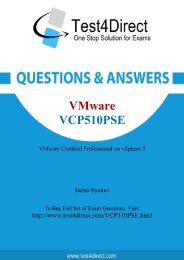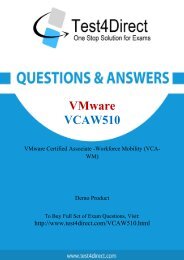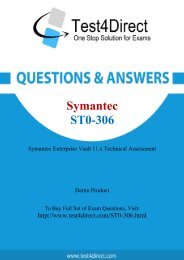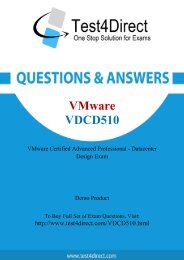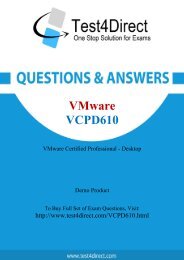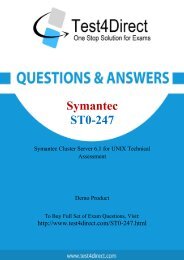VCPN610-demo
You also want an ePaper? Increase the reach of your titles
YUMPU automatically turns print PDFs into web optimized ePapers that Google loves.
VMware<br />
<strong>VCPN610</strong><br />
VMware Certified Professional - Network Virtualization<br />
Exam<br />
Demo Product<br />
To Buy Full Set of Exam Questions, Visit:<br />
http://www.test4direct.com/<strong>VCPN610</strong>.html
Question: 1<br />
What are two advantages for using NSX for vSphere's Logical Switching? (Choose two.)<br />
A. Expands the number of available VLANs.<br />
B. Allows for Layer 2 switching over Layer 3 infrastructure.<br />
C. Distributes Layer 3 data across multiple hypervisors.<br />
D. Provides for 10,000 logical segments.<br />
Question: 2<br />
Which statement describes the traffic throughput of the NSX Distributed Firewall?<br />
Question: 3<br />
Question: 4<br />
Answer: B, D<br />
A. By decoupling the firewall services from the virtualization layer, traffic is directed to the<br />
distribution layer for firewall processing within a service module.<br />
B. By deploying firewall software on a per virtual machine basis, firewall services will be distributed<br />
across multiple compute nodes.<br />
C. Firewall services are implemented as kernel modules and provide traffic filtering between the<br />
virtual machine's vNIC and the vSwitch.<br />
D. Firewall services are distributed as a software firewall appliance and may be deployed on more<br />
than one ESXi host for scalability and high availability.<br />
Answer: C<br />
Using VMware's best practices, choose two statements that define the best solution for scaling layer<br />
2 services for the virtual network. (Choose two.)<br />
A. Employ a layer 2 switched network.<br />
B. Employ a layer 3 switched network.<br />
C. Use GRE for an overlay network.<br />
D. Use VXLAN for an overlay network.<br />
Answer: B, D<br />
Which component provides for installation of NSX hypervisor kernel components and user world<br />
agents?<br />
A. NSX Controller<br />
B. NSX Edge Virtual Appliance<br />
C. NSX Manager
D. vCloud Automation Center<br />
Answer: C<br />
Question: 5<br />
Which NSX service or feature provides optimized management of virtual machine broadcast (ARP)<br />
traffic?<br />
A. NSX Controller<br />
B. NSX Manager<br />
C. Edge Services Gateway<br />
D. VTEP<br />
Question: 6<br />
Question: 7<br />
Question: 8<br />
Answer: A<br />
You are tasked with designing a data center architecture that should maximize the use of vMotion<br />
within your environment. You must use these VMware best practices:<br />
The network must utilize widely offered layer 2 switching and layer 3 switching services<br />
Purchase of new equipment should be minimized<br />
Which two network design architectures will provide the requirements for vMotion in your data<br />
center? (Choose two.)<br />
A. Utilize layer 3 switching from the access layer through the core.<br />
B. Employ layer 2 multipathing using a standardized protocol.<br />
C. Deploy a flat, traditional layer 2 switched network.<br />
D. Deploy an overlay technology for the deployment of your virtual network.<br />
Answer: A, D<br />
Which two statements describe the benefits provided by firewall services deployed by NSX? (Choose<br />
two.)<br />
A. Firewall services deployed using a software appliance will provide east-west traffic filtering and<br />
security.<br />
B. Firewall services deployed using a distributed kernel module will provide east-west traffic filtering<br />
and security.<br />
C. Firewall services providing edge security services uses a virtual appliance and is centrally<br />
managed.<br />
D. Firewall services providing edge security services uses a distributed kernel module.<br />
Answer: B, C
Which two statements are valid regarding vCloud Networking and Security (vCNS) and NSX? (Choose<br />
two.)<br />
A. Both vCNS and NSX support multiple hypervisor environments.<br />
B. NSX provides support for multiple hypervisor environments, vCNS does not.<br />
C. Both vCNS and NSX support dynamic routing protocols.<br />
D. NSX supports dynamic routing protocols, vCNS does not.<br />
Question: 9<br />
An administrator wishes to upgrade to NSX from the following infrastructure:<br />
vCenter Server 4.1<br />
vShield 5.0<br />
ESXi hosts 4.1<br />
What is a valid, minimum set of steps to properly upgrade this environment to NSX?<br />
A. 1. Upgrade vCenter Server 4.1 to vCenter Server 5.5<br />
2. Upgrade vShield 5.0 to vShield 5.5<br />
3. Upgrade ESXi hosts to ESXi 5.1 or greater<br />
4. Install the NSX upgrade bundle<br />
B. 1. Upgrade vCenter Server 4.1 to vCenter Server 5.1<br />
2. Upgrade vCenter Server 5.1 to vCenter Server 5.5<br />
3. Upgrade ESXi hosts to ESXi 5.1 or greater<br />
4. Install the NSX upgrade bundle<br />
C. 1. Upgrade vCenter Server 4.1 to vCenter Server 5.5<br />
2. Upgrade ESXi hosts to ESXi 5.1 or greater<br />
3. Install the NSX upgrade bundle<br />
D. 1. Upgrade vCenter Server 4.1 to vCenter Server 5.5<br />
2. Upgrade vShield 5.0 to vShield 5.5<br />
3. Install the NSX upgrade bundle<br />
Question: 10<br />
Answer: B, D<br />
Answer: A<br />
Layer 2 Multipathing (L2MP) and Multi-chassis Etherchannel (MEC) features have distinct scaling<br />
differences with the network switching and routing services provided by NSX.<br />
Which two statements provide a proper contrast of these services? (Choose two.)<br />
A. Multi-chassis Etherchannel features provide higher utilization of Ethernet links within a defined<br />
L2/L3 distribution area.<br />
B. Multi-Chassis Etherchannel features provide an easy ability to scale a VLAN across the data center.<br />
C. NSX provides a method to transparently deploy L2MP protocols upon existing data center<br />
installations without service disruption.<br />
D. NSX provides a method to deploy scalable L2/L3 services on existing data center installations.<br />
Answer: A, D
Question: 11<br />
An administrator has recently deployed NSX, but is still using a pair of physical network security<br />
devices. The administrator wants to use the physical security devices to filter virtual machine traffic<br />
hosted in the overlay network.<br />
Which NSX component will provide the connectivity between the overlay and the physical network?<br />
A. Distributed Firewall<br />
B. NSX Controller<br />
C. Edge Services Gateway<br />
D. Logical Router<br />
Question: 12<br />
Which two are valid statements regarding third-party services and NSX? (Choose two.)<br />
Question: 13<br />
Question: 14<br />
Answer: D<br />
A. Third party services are automatically registered with NSX Manager.<br />
B. Third party services can either be automatically or manually registered with NSX Manager.<br />
C. Third party services require the deployment of a virtual appliance.<br />
D. Third party services may or may not utilize a service virtual appliance.<br />
Answer: B, D<br />
Which VMware NSX for vSphere component can be created on-demand using vCloud Automation<br />
Center?<br />
A. The logical switch<br />
B. The logical distributed router<br />
C. The distributed firewall<br />
D. The NSX Edge Services Gateway<br />
What is one way that NSX improves network performance?<br />
Answer: A<br />
A. Virtual machines in different subnets residing on the same host route traffic through an NSX<br />
controller, keeping traffic on the host.<br />
B. Virtual machines in different subnets residing on the same host route traffic through an NSX logical<br />
router, keeping traffic on the host.<br />
C. Virtual machines in different subnets residing on the same host route traffic through an NSX Edge<br />
gateway, keeping traffic on the host.<br />
D. Virtual machines in different subnets residing on the same host route traffic through an NSX<br />
switch, keeping traffic on the host.
Answer: B<br />
Question: 15<br />
Which statement is true regarding deploying NSX over a physical network?<br />
A. OSPF can be used for Management traffic in a Layer 3 fabric design.<br />
B. NSX can implement IPv6 on an IPv4 physical network.<br />
C. Routing is supported on bridged interfaces.<br />
D. VLANs are not required to separate traffic between virtual machines.<br />
Answer: B<br />
Question: 16<br />
How does NSX simplify physical network design?<br />
A. VLANs are moved into the virtual network for virtual machine traffic, eliminating the need to use<br />
PVLANs on the physical network.<br />
B. Network administrators only need to configure routing on the physical network for virtual machine<br />
traffic since all other network functions are moved to the virtual network.<br />
C. Transport zones are created in the virtual network for virtual machine traffic, removing the need to<br />
make changes to the physical network.<br />
D. Virtual network integration can make changes to the physical network programmatically using<br />
REST API calls which automates network changes and increases agility.<br />
Answer: C
THANKS FOR TRYING THE DEMO OF OUR PRODUCT<br />
Visit Our Site to Purchase the Full Set of Actual <strong>VCPN610</strong> Exam Questions With Answers.<br />
http://www.test4direct.com/<strong>VCPN610</strong>.html<br />
We Also Provide Practice Exam Software That Simulates Real Exam Environment And Has<br />
Many Self-Assessment Features. Download Free Product Demo From:<br />
http://www.test4direct.com/<strong>VCPN610</strong>.html<br />
Money Back Guarantee<br />
Check Out Our Customer Testimonials




